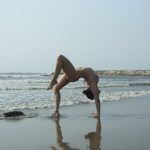Gastrocnemius recession, also known as gastrocnemius lengthening, is a surgical procedure that aims to increase the flexibility and range of motion in the ankle and foot. The gastrocnemius muscle is located at the back of the lower leg and is responsible for plantar flexion of the foot, which is the movement of pointing the toes downward. When the gastrocnemius muscle is tight or shortened, it can lead to limited ankle dorsiflexion, which is the movement of pulling the toes upward towards the shin. This limited range of motion can cause issues with walking, running, and other activities that require full ankle mobility.
During a gastrocnemius recession, the surgeon makes an incision in the back of the lower leg and carefully lengthens the gastrocnemius muscle to allow for greater flexibility in the ankle joint. This procedure is often recommended for individuals who have tightness in the calf muscles due to conditions such as equinus deformity, Achilles tendonitis, or plantar fasciitis. Gastrocnemius recession can help alleviate pain and discomfort associated with these conditions and improve overall function of the lower leg and foot.
Gastrocnemius recession is typically performed as an outpatient procedure, meaning that patients can go home the same day as the surgery. Recovery time varies from person to person, but most individuals can expect to return to normal activities within a few weeks following the procedure. It is important to follow the post-surgery rehabilitation plan provided by the surgeon to ensure a successful outcome and long-term benefits from the surgery.
Key Takeaways
- Gastrocnemius recession is a surgical procedure to lengthen the calf muscle and improve ankle flexibility.
- Benefits of gastrocnemius recession include increased ankle dorsiflexion, improved gait, and reduced risk of injury.
- Preparing for gastrocnemius recession surgery involves discussing medical history, potential risks, and post-surgery expectations with the surgeon.
- Post-surgery recovery and rehabilitation may include physical therapy, gradual return to activity, and monitoring for complications.
- Incorporating gastrocnemius recession into training and exercise can help improve overall flexibility and performance, but should be done under the guidance of a healthcare professional.
- Potential risks and complications of gastrocnemius recession include infection, nerve damage, and prolonged recovery time.
- Consultation and evaluation for gastrocnemius recession should involve a thorough assessment of the patient’s medical history, physical examination, and discussion of treatment goals with the surgeon.
Benefits of Gastrocnemius Recession for Flexibility
Gastrocnemius recession offers several benefits for individuals looking to improve flexibility and range of motion in the ankle and foot. By lengthening the gastrocnemius muscle, this surgical procedure can help alleviate tightness and restriction in the calf muscles, allowing for greater ankle dorsiflexion. This increased flexibility can be especially beneficial for athletes and active individuals who rely on full ankle mobility for activities such as running, jumping, and cutting movements.
Improved ankle flexibility can also help reduce the risk of injuries such as Achilles tendonitis, plantar fasciitis, and calf strains. By addressing tightness in the gastrocnemius muscle, individuals may experience less pain and discomfort during physical activity and be less prone to overuse injuries in the lower leg and foot. Additionally, increased ankle dorsiflexion can lead to better overall biomechanics during movement, which may enhance performance and efficiency in sports and exercise.
Furthermore, greater ankle flexibility can have a positive impact on everyday activities such as walking, climbing stairs, and standing for extended periods. Individuals who have struggled with limited ankle mobility due to tight calf muscles may find that gastrocnemius recession allows them to move more freely and comfortably in their daily lives. Overall, the benefits of improved flexibility from gastrocnemius recession can have a significant impact on both athletic performance and quality of life.
Preparing for Gastrocnemius Recession Surgery
Preparing for gastrocnemius recession surgery involves several important steps to ensure a successful outcome and smooth recovery. The first step is to schedule a consultation with a qualified orthopedic surgeon who specializes in foot and ankle procedures. During this initial appointment, the surgeon will conduct a thorough evaluation of the patient’s lower leg and foot, including assessing range of motion, strength, and any existing conditions that may be contributing to tightness in the calf muscles.
Once the decision has been made to proceed with gastrocnemius recession, the surgeon will provide detailed pre-operative instructions to help prepare for the surgery. This may include guidelines for medications to avoid prior to the procedure, as well as recommendations for physical therapy exercises to optimize muscle strength and flexibility leading up to the surgery date. It is important for patients to follow these instructions closely to minimize any potential risks or complications associated with the surgery.
In addition, patients should make arrangements for transportation to and from the surgical facility on the day of the procedure, as well as for assistance at home during the initial stages of recovery. Preparing a comfortable recovery space at home with necessary supplies such as ice packs, elevation pillows, and non-slip footwear can help make the post-surgery period more manageable. By taking these proactive steps to prepare for gastrocnemius recession surgery, patients can set themselves up for a successful experience and optimal results.
Post-Surgery Recovery and Rehabilitation
| Metrics | Recovery Time | Physical Therapy Sessions | Pain Level |
|---|---|---|---|
| Week 1 | 1-2 weeks | 3 times per week | High |
| Week 2 | 2-4 weeks | 2 times per week | Moderate |
| Week 3 | 4-6 weeks | 1 time per week | Mild |
Following gastrocnemius recession surgery, patients will need to adhere to a comprehensive post-operative recovery and rehabilitation plan to promote healing and restore function in the lower leg and foot. In the immediate post-surgery period, it is common for patients to experience some discomfort, swelling, and limited mobility in the surgical area. To manage these symptoms, patients are typically advised to elevate the leg, apply ice packs, and take prescribed pain medications as directed by their surgeon.
As healing progresses, patients will begin physical therapy to gradually regain strength and flexibility in the calf muscles and ankle joint. Physical therapy exercises may include gentle stretching, range of motion movements, and progressive strengthening exercises tailored to each individual’s specific needs. The goal of rehabilitation is to gradually increase weight-bearing activities and restore normal gait patterns while minimizing the risk of complications such as muscle weakness or re-injury.
Throughout the recovery process, patients will have regular follow-up appointments with their surgeon to monitor progress and address any concerns or questions that may arise. It is important for patients to communicate openly with their healthcare team about their recovery experience and adhere to all recommended guidelines for activity modification, wound care, and rehabilitation exercises. By actively participating in post-surgery recovery and rehabilitation, patients can optimize their outcomes from gastrocnemius recession surgery and return to their desired level of activity with improved flexibility and function in the lower leg.
Incorporating Gastrocnemius Recession into Training and Exercise
After completing post-surgery recovery and rehabilitation, individuals who have undergone gastrocnemius recession can gradually incorporate specific training and exercise strategies to maximize the benefits of increased ankle flexibility. This may include targeted stretching exercises for the calf muscles to maintain optimal range of motion in the ankle joint. Regular stretching routines can help prevent re-tightening of the gastrocnemius muscle and promote ongoing flexibility in the lower leg.
In addition to stretching, individuals may benefit from incorporating strengthening exercises into their regular fitness routine to support overall lower leg function. This could involve exercises such as calf raises, heel drops, and resistance band work to build strength in the calf muscles and improve stability in the ankle joint. By focusing on balanced strength and flexibility training, individuals can enhance their performance in sports and activities while reducing the risk of future injuries related to calf tightness.
Furthermore, individuals who have undergone gastrocnemius recession may find value in working with a qualified physical therapist or athletic trainer to develop a personalized exercise program that addresses their specific needs and goals. These professionals can provide guidance on proper technique, progression of exercises, and modifications based on individual abilities and limitations. By integrating gastrocnemius recession into their training and exercise routine, individuals can maintain long-term benefits from the surgery and continue to enjoy improved flexibility and function in their lower leg.
Potential Risks and Complications of Gastrocnemius Recession

While gastrocnemius recession is generally considered a safe and effective procedure for addressing tightness in the calf muscles, there are potential risks and complications that patients should be aware of before undergoing surgery. Like any surgical procedure, there is a risk of infection at the incision site following gastrocnemius recession. Patients are typically prescribed antibiotics to reduce this risk, but it is important to monitor for signs of infection such as increased redness, swelling, or drainage from the incision.
Another potential complication of gastrocnemius recession is nerve damage or injury during the surgical process. The surgeon must carefully navigate around nerves in the lower leg to avoid causing damage that could lead to numbness or weakness in the foot or ankle. Patients should be vigilant about reporting any unusual sensations or loss of sensation following surgery to ensure prompt evaluation by their healthcare provider.
Additionally, there is a risk of overcorrection or undercorrection of tightness in the gastrocnemius muscle during surgery. Overcorrection could lead to excessive laxity in the calf muscles, while undercorrection may not fully address existing limitations in ankle flexibility. Surgeons must carefully assess each patient’s individual needs and goals to achieve an optimal outcome from gastrocnemius recession.
It is important for patients considering gastrocnemius recession to thoroughly discuss potential risks and complications with their surgeon prior to undergoing the procedure. By understanding these factors and being proactive about monitoring their recovery experience, patients can minimize potential complications and achieve successful results from gastrocnemius recession surgery.
Consultation and Evaluation for Gastrocnemius Recession
Individuals who are interested in exploring gastrocnemius recession as a treatment option for tightness in their calf muscles should begin by scheduling a consultation with a qualified orthopedic surgeon who specializes in foot and ankle procedures. During this initial appointment, the surgeon will conduct a comprehensive evaluation of the patient’s lower leg and foot to assess range of motion, strength, and any existing conditions that may be contributing to calf tightness.
The consultation provides an opportunity for patients to discuss their symptoms, goals, and concerns with the surgeon while gaining a better understanding of what to expect from gastrocnemius recession surgery. Patients should come prepared with questions about the procedure itself, expected recovery timeline, potential risks and complications, as well as post-surgery rehabilitation plans. Open communication with the surgeon is key to ensuring that patients feel informed and confident about moving forward with gastrocnemius recession.
In some cases, additional diagnostic tests such as imaging studies or gait analysis may be recommended to further assess the extent of calf tightness and its impact on overall lower leg function. These tests can provide valuable information for both the patient and surgeon when making decisions about whether gastrocnemius recession is an appropriate treatment option.
Ultimately, undergoing a thorough consultation and evaluation for gastrocnemius recession allows patients to make informed decisions about their care while establishing a collaborative relationship with their healthcare team. By taking this proactive approach, individuals can work towards addressing calf tightness through surgical intervention with confidence in their treatment plan.
If you’re interested in learning more about gastrocnemius recession, you should check out this article on studentssharing.org. This website offers a wealth of information on various medical topics, including the causes, symptoms, and treatment options for gastrocnemius recession. It’s a great resource for anyone looking to expand their knowledge on this condition.
FAQs
What is a gastrocnemius recession?
A gastrocnemius recession is a surgical procedure that involves lengthening the calf muscle (gastrocnemius) to relieve tension and tightness in the Achilles tendon and improve ankle flexibility.
Why is a gastrocnemius recession performed?
A gastrocnemius recession is performed to treat conditions such as Achilles tendonitis, plantar fasciitis, and equinus deformity, which are often caused by tightness in the calf muscle.
How is a gastrocnemius recession performed?
During a gastrocnemius recession, the surgeon makes an incision in the calf muscle and releases a portion of the gastrocnemius tendon, allowing the muscle to lengthen and reduce tension on the Achilles tendon.
What are the potential risks and complications of a gastrocnemius recession?
Potential risks and complications of a gastrocnemius recession may include infection, nerve damage, muscle weakness, and prolonged recovery time.
What is the recovery process like after a gastrocnemius recession?
After a gastrocnemius recession, patients typically undergo physical therapy to regain strength and flexibility in the calf muscle and Achilles tendon. Full recovery can take several months.
Who is a good candidate for a gastrocnemius recession?
Good candidates for a gastrocnemius recession are individuals who have tightness in the calf muscle causing pain and limited ankle flexibility, and have not responded to non-surgical treatments.










